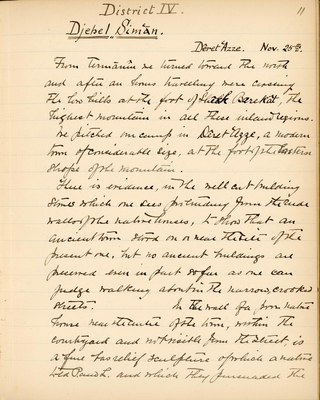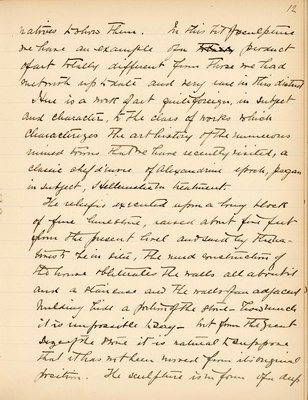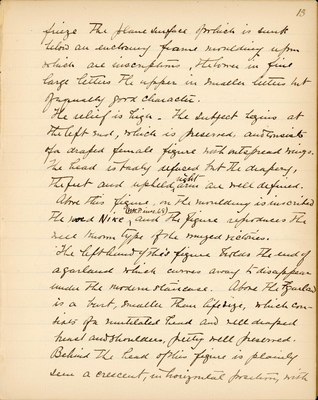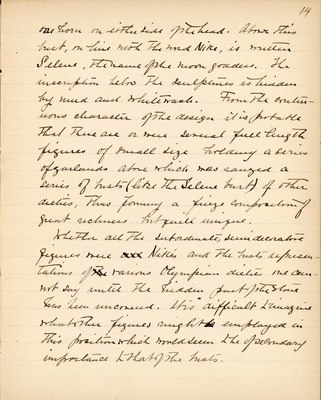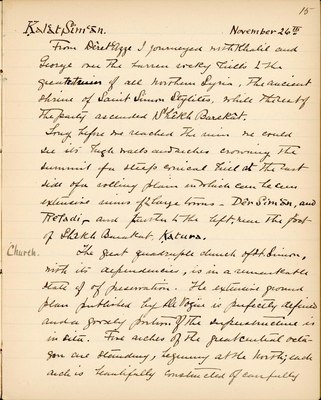Pages
BSY_FB_15-11
11
District IV
From Termānîn we turned toward the north and after an hours travelling were crossing the low hills at the foot of Shêkh Barekât, the highest mountain in all these inland regions.
We pitched our camp in Dêret ʿAzze, a modern town of considerable size, at the foot of the Eastern slope of the mountain.
There is evidence, in the well cut building stones which one sees protuding from the rude walls of the native houses, to show that an ancient town stood on or near the site of the present one, but no ancient buildings are preserved even in part so far as one can judge walking about in the narrow, crooked streets. In the wall of a poor native house near the centre of the town, within the courtyard and not visible from the street, is a fine bas relief sculpture of which a native led P. and L. and which they pursuaded the
BSY_FB_15-12
12
natives to show them. In this bit of sculpture we have an example of a product of art totally different from those we had met with up to date and very rare in this district.
Here is a work of art quite foreign, in subject and character, to the class of works which characterizes the art history of the numerous ruined towns that we have recently visited, a classic chef-d'oeuvre of Alexandrine epoch, pagan in subject, Hellenistic in treatment.
The relief is executed upon a long block of fine limestone, raised about five feet from the present level and said by the natives to be in situ, the mud construction of the house obliterates the walls all about it and a staircase and the walls of an adjacent building hide a portion of the stone - how much it is impossible to say - but from the great size of the stone it is natural to suppose that it has not been moved from its original position. The sculpture is in form of a deep
BSY_FB_15-13
13
freize the plane surface of which is sunk below an enclosing frame moulding upon which are inscriptions, the lower in fine large letters the upper in smaller letters but of equally good character.
The relief is high - the subject begins at the left end, which is preserved, and consists of a draped female figure with outspread wings. The head is badly defaced but the drapery, the feet and upheld ^ right ^ arm are well defined.
Above this figure, on the moulding is inscribed the word Nike ^ (W.K.P insc 68) ^ and the figure reproduces the well known type of the winged victories.
The left hand of this figure holds the end of a garland which curves away to disappear under the modern staircase. Above the garland is a bust, smaller than lifesize, which consists of a mutilated head and well draped head and shoulders, pretty well preserved. Behind the head of this figure is plainly seen a crescent, in horizontal position, with
BSY_FB_15-14
14
one horn on either side of the head. Above this bust, on line with the word Nike, is written Selene, the name of the moon goddess. The inscription below the sculptures is hidden by mud and whitewash. From the continuous character of the design it is probable that these are or were several full length figures of small size holding a series of garlands above which was ranged a series of busts (like the Selene bust) of other dieties, this forming a frieze composition of great richness but quite unique.
Whether all the subordinate, semidecorative figures were Nike's and the busts representations of various Olympian dieties one cannot say until the hidden part of the stone has been uncovered. It is difficult to imagine what these figures might be employed in this position which would seem to be of secondary importance to that of the busts.
BSY_FB_15-15
15
Ḳalʿat Simʿān November 26, 1899
From Dêret ʿAzze I journeyed with Khalil and George over the barren rocky hills to the greatest ruin of all northern Syria, the ancient shrine of Saint Simeon Stylites, while the rest of the party ascended Shêkh Barekât.
Long before we reached the ruin we could see its high walls and arches crowning the summit of a steep conical hill at the east side of a rolling plain in which can be seen extensive ruins of 2 large towns, Dêr Simʿān and Refadi - and further to the left, near the foot of Shêkh Barekât, Ḳatura.
Church. The great quadruple church of St. Simeon, with its dependencies, is in a remarkable state of preservation. The extensive ground plan published by DeVogüé is perfectly defined and a goodly portion of the superstructure is in situ. Five arches of the great central octagon are standing, beginning at the north; each arch is beautifully constructed of carefully
